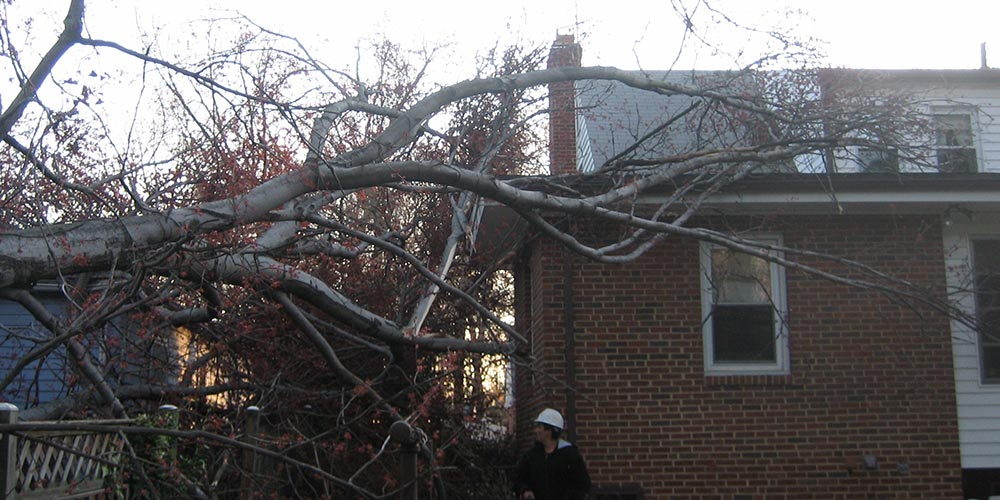
How to Manage the Risk of a Tree Falling on Your Home
During winter and other storm seasons, there is a high risk of weak trees falling on your property. You don’t want this, do you?
According to tree services providers, you need to be ultra-cautious to ensure that the trees don’t fall on your property.
How to tell a tree is at risk.
There are several things you can look out for to tell if your tree is at risk. You should keep an eye on the tree’s limbs as well as its base, particularly when storm season approaches in your state.
If you notice a multitude of branches down that are rotted or dead, that can indicate that your tree can fall. While at it, also check the root ball and ensure that it’s not progressively coming out of the ground.
The root ball is the collection of roots beneath the tree trunk. You should look for movement in the ground at the tree’s base on a windy day. If you see a problem, it’s time to fix it.
If you identify a problem or you’d like to have someone else look at it, you should contact an arborist.
The professionals will assess your trees, advise you on potential hazards, trim branches, or remove the entire tree.
Besides your trees, you also should keep a watch on your neighbors’ trees that may pose harm to your property and speak with them if necessary.
If you’re concerned their tree is unhealthy and they’re not doing anything about it, you can contact the council.
What should you do when a tree falls on your property?
Even with the best preventative measures, it’s not unusual for a tree to fall on your property.
Be safe and contact emergency.
The first concern if a tree falls on your house is to protect yourself and your family. Remember that your house and property can be fixed or replaced, but you don’t have a spare life.
The safety and health of your loved ones, on the other hand, are priceless.
Make sure everyone is safe. If anyone requires medical assistance, dial 911 immediately. If the tree caused power lines to fall, or if you see fire or smell smoke, notify the fire department immediately. You’ll be happy you did.
Turn off the power and gas.
You should turn off the power and gas in your home even if there is no immediate threat and you know how.
Doing this is a preventative action that could prevent a fire from starting if the tree fell and injured a gas line.
Get in touch with the power company.
When a large tree falls, it frequently destroys electrical lines, resulting in an outage in your neighborhood. You should notify the power company of any damage to power lines or outages caused by the downed tree.
You should call the power company and let them know of the outage. You can report downed electrical lines, power outages, and harmful conditions.
Call an insurance agent.
You should call your home insurance agent once everyone is safe and the authorities have been notified. They can advise you on the next actions to take and explain what is and is not covered by your homeowner’s policy.
Before filing your claim, an insurance assessor will likely visit your home to check the damage. In some circumstances, you may be able to speed up the process by emailing images of the damage to your insurance agent.
Remove the tree
You should remove the tree. Ensure that a reputable and professional large tree removal company removes the tree.
Many people hire the first company that they come about, but you shouldn’t do this. Instead, get in touch with several companies and compare their quotes. As a rule of thumb, you should go with the company that gives you the best deal.
Repair the roof
Following the removal of the tree, you’ll need to contact a reputable local roofing contractor to check and repair your roof. Depending on the severity of the damage, a partial roof replacement may be necessary–and may even be covered by your homeowner’s insurance policy.
Even if there is no visible roof damage, you should get your roof assessed. This is because there could be damage under the shingles that leads to roof leaks later on.
Inspect your home
Finally, get your home and foundation evaluated, particularly if you notice cracks or breaks in the foundation.
When a tree falls, the enormous root ball goes with it. This movement might cause foundation damage that you may not notice immediately.
Unfortunately, over time, this might cause structural damage to your home or enable moisture and leaks.
A thorough house inspection will help you detect issues and put your mind at ease.
What happens when the neighbor’s tree falls on the house?
In general, your insurance coverage will cover damage to your property regardless of who planted the tree. To put it another way, if a tree falls on your house, call your insurance provider.
What if your tree falls on your neighbor’s property?
You are most likely only accountable if you were negligent about the tree’s state. You may protect yourself by having your property’s trees evaluated, trimmed, and, if required, removed.
What if the tree falls on a fence or property line
The best-case scenario is that you and your neighbors get along well and can split the cost of removing the tree and mending the fence.
Both of you can call the insurance firms and let them determine how to proceed.
How to tell your tree is about to fall.
Dead trees are the most vulnerable to falling. Disease, harsh weather, and other factors can increase the chances of a tree falling.
You should find an arborist Kensington to help you determine whether a tree will likely fall. If it is, remove it as soon as possible before it becomes problematic.
